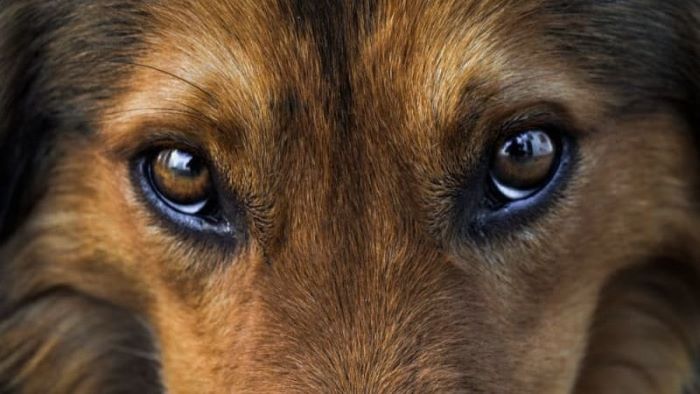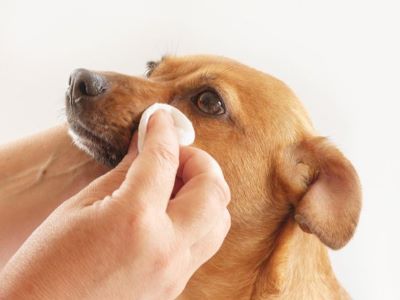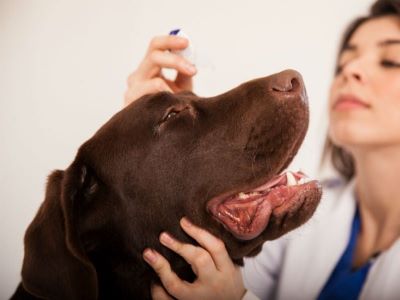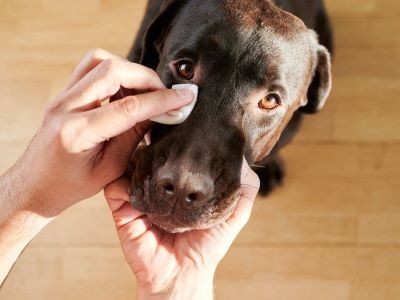Conjunctivitis in dogs also known as pink eye is a common condition. What will you do if you find the red and watery eyes of your dog? Stay tuned to know…

In this article, we are going to understand what is conjunctivitis in dogs. How can we treat and prevent this condition? So without further ado let’s start.⏯️
What Is Conjunctivitis in Dogs?
Conjunctivitis, also known as pink eye,👀 is an inflammatory condition that affects the conjunctiva, which is the thin, transparent tissue that covers the inner eyelid and the white part of the eye in dogs.
The clinical signs of conjunctivitis are usually the same regardless of the underlying cause and may include redness, swelling, discharge, and squinting. As per Dr Katie Grzyb from PetMD,🧑⚕️ there are three main types of conjunctivitis in dogs, let’s understand them in detail:
- Allergic Conjunctivitis
This type is caused by an allergic reaction and can be seasonal. It is not contagious. Allergic Conjunctivitis: Allergies to environmental factors like pollen,🥀 dust, or certain foods🥣 can lead to allergic conjunctivitis in dogs. This type of conjunctivitis is often seasonal🔁 and may affect both eyes.

- Viral Conjunctivitis
This type is caused by a virus and can spread easily and rapidly. It usually takes around 3 weeks📅 for the dog to fully recover.🦠
- Bacterial Conjunctivitis
This type is caused by bacteria and can spread to other dogs easily. It requires quick treatment with antibiotics💊 to prevent complications.
Causes of Conjunctivitis
Bacterial and viral infections can lead to conjunctivitis. Contagious infections can spread between dogs in close contact.
Dogs can develop allergic conjunctivitis in response to allergens like pollen, dust mites, or certain foods. Allergic reactions may affect both eyes. Chemical irritants, such as shampoos,🧴 soaps,🧼 or foreign objects like dust or sand,🏖️ can irritate the conjunctiva and lead to conjunctivitis.
“In autoimmune conjunctivitis, the dog’s immune system mistakenly attacks its own conjunctival tissues. Trauma to the eye or irritation from foreign bodies, smoke, or environmental pollutants”, confirms Courtney Barnes from WebMD.🏥
Many dog breeds with prominent eyes, such as Pugs or Bulldogs, are more prone to developing conjunctivitis due to their eye shape, which can lead to reduced tear drainage and increased vulnerability to infections.🦠

Symptoms of Conjunctivitis in Dogs
Here are some common symptoms of conjunctivitis in dogs[1]:
- Redness in the eyes: The conjunctiva becomes inflamed and appears pink or red. The membranes surrounding the eye👁️ become swollen due to inflammation.
- Eye discharge: Can be clear and watery or thick and purulent depending on the cause. Yellow/green discharge often indicates a bacterial infection.🦠
- Squinting eyes: Dogs will squint or keep their eyes closed because of discomfort and sensitivity to light. Increased tear production is the body’s way of flushing out irritants.
- Rubbing at eyes: Dogs will paw at their eyes or rub against objects in an attempt to relieve irritation.
- Sensitivity to light: Dogs may avoid bright areas due to light causing pain and discomfort in infected eyes. Rapid blinking is a reflex to try to flush out irritants in the eye.☀️
- Signs of pain: Whining, reluctance to be touched around the eyes, and lethargy can indicate discomfort. Thick, pus-like discharge can develop in severe bacterial cases if left untreated.

How Do Vets Diagnose Conjunctivitis?
To diagnose conjunctivitis in dogs, a vet will perform a complete physical examination as well as a thorough eye check-up🩺 to look for any medical problems that may be causing the conjunctivitis.
The vet will look for symptoms such as redness, swelling, discharge, and squinting. They may also ask about the dog’s symptoms when they started, and any recent activities that could be relevant.
They may also perform additional tests such as tear tests, stains to look for corneal ulcers or lesions, measurement of intraocular pressure, or a biopsy. Mostly in non-severe cases, only examination is enough.📝
Treatment of Conjunctivitis
If you suspect your dog has conjunctivitis, it’s crucial to consult a vet🧑⚕️ for a proper diagnosis and treatment plan. The vet will determine the cause of the conjunctivitis and recommend the most appropriate treatment.
1. Medications
Seek veterinary care for proper diagnosis and treatment. The vet will prescribe appropriate medications like antibiotic eye drops based on the cause.
Follow the vet’s instructions carefully when administering any prescribed eye medications. Complete the entire course as directed, even if symptoms start improving.📈
2. Allergen Avoidance
If allergies are the cause, try to limit your dog’s exposure to the allergens. Keep them inside during peak pollen season or eliminate allergenic foods.

Use a warm, damp cloth to gently compress the affected eye. This can help reduce swelling and discharge. Make sure the cloth is at a comfortable temperature.🌡️
3. Hygiene
Keep the area around the eyes clean by gently wiping the discharge away with a separate damp cloth. Avoid touching the eye directly.
For dogs with recurrent conjunctivitis, making environmental changes such as reducing exposure to dust, smoke,🌫️ or other irritants can be beneficial.
If the conjunctivitis is infectious, take precautions to prevent the spread to other dogs. Isolate affected dogs, wash your hands thoroughly after handling them, and avoid sharing items like towels or grooming tools.🪥
Prevention of Conjunctivitis in Dogs
Prevention of conjunctivitis in dogs is possible. Here are some tips to help prevent conjunctivitis in dogs:
- Keep your dog’s eyes clean by gently wiping with a damp cloth daily.⌛ This removes debris and discharge that could irritate the eyes.
- If your dog has allergies that cause conjunctivitis, limit exposure to environmental allergens when possible. Keep them indoors when pollen🥀 is high or switch their diet if food allergies are a factor.
- Maintain a clean, dust-free home environment for your dog. Use air purifiers if needed and avoid smoking around pets, as irritants can worsen conjunctivitis.
- Be careful with toys and objects your dog plays with to avoid injuries. Make sure the edges are smooth and they are safe for play.🛝
Ensure your dog stays well-hydrated with fresh, clean drinking water available at all times. Dehydration can contribute to dry eyes.

Home Remedies for Conjunctivitis
Your vet may recommend using over-the-counter artificial tear solutions for lubrication if the conjunctivitis is due to dry eyes. A saline solution (made of salt and water)💧 can be used to rinse your dog's eyes, especially if there's discharge.
Make sure it is sterile and at the right concentration. If the conjunctivitis is allergy-related, consult your vet for guidance on managing allergies at home. This may include reducing allergens in your dog’s environment or dietary changes.🥣
Can Humans Catch Conjunctivitis From a Dog?
“Humans can catch conjunctivitis from their pet, but this is fortunately a rare occurrence. This is possible and owners suffering from conjunctivitis should make sure they wash🌊 their hands before cuddling with their furry best friend. It’s important to keep an eye on your dog’s eyes👀 for any changes“, confirms the experts at Purina.
FAQs
❓What Causes Dogs to Get Conjunctivitis?
This condition in dogs can be caused by a number of issues including allergies, irritation from foreign bodies, viral infections, tumours in the eye region, breed-specific conditions such as nodular episcleritis in Collies, tear film deficiency, abnormalities of the eye, obstructed tear ducts, parasitic infections.
❓How Do I Treat Conjunctivitis in My Dog?
If a bacteria or virus is the cause of your dog’s conjunctivitis, treatment in the form of antibiotics or antiviral medication will be recommended. Sometimes a dog allergy can your eye symptoms. In this case, as well, specific treatment will be prescribed such as antihistamines or steroids.
❓Is Conjunctivitis in Dogs Contagious to Humans?
Additionally, some types of canine conjunctivitis (usually bacterial) can potentially be passed to humans, although this is extremely uncommon. It’s important for anyone handling an infected dog to wash their hands thoroughly to prevent the infection from spreading to other animals or themselves.
❓Is Saltwater Good for Conjunctivitis in Dogs?
Rinse your dog’s eye and eye area with a simple saline solution, which can be purchased from a veterinarian or pharmacy, or made with a teaspoon of salt water in a cup of warm water. Carefully instill into the corner of your dog’s eye dip a cotton ball in the solution and wipe away discharge from around the eye.
Summary
In conclusion, conjunctivitis in dogs is a common and treatable condition. If you suspect that your dog has conjunctivitis then it is advisable to visit the vet and have your dog checked for the infection.🦠
The vet will examine the dog thoroughly and provide you with the diagnosis and treatment options, also if your dog’s infection is in mild stages then you can use some home remedies as well.
Remember, it is our responsibility as responsible pet parents to look after our furry friends and provide them healthy and happy life.💖
Reference:
- Cross, B. (n.d.-a). Conjunctivitis in dogs. Blue Cross.



